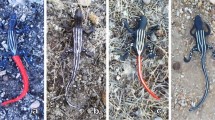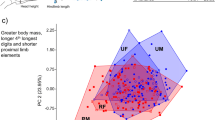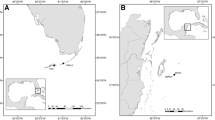Abstract
Colorful tails that become cryptic during ontogeny are found in diverse taxa. Nevertheless, the evolutionary bases for this change remain debated. Recent work suggests that colorful tails, deflective displays, and striped patterns may represent antipredator mechanisms used by immature lizards to compensate for being more active and hence more vulnerable to predation (increased movement hypothesis, IMH). I challenged the generality of IMH by comparing foraging behavior and frequency of tail displays across five Acanthodactylus lizards that vary in fundamental life history traits, before and after the tail changed color. As these species underwent changes in tail coloration, they congruently adopted less risky behaviors and reduced the frequencies of tail displays. Contrary to expectation, in two species, the hatchling risky behavior resulted not from increased movements but from longer stay in exposed microhabitats. I suggest that colorful tails and deflective tail displays are synergistic antipredator mechanisms neonates use to minimize the fitness consequences of using various risky behaviors rather than increased movement alone.



Similar content being viewed by others
References
Alford RA (1999) RAMAN manual: documentation for RAMAN version 1.73. Available from URL: http://www.pibweb.com/ross/RAMAN/RAMAN.htm
Arnold EN (1984) Evolutionary aspects of tail shedding in lizards and their relatives. J Nat Hist 18:127–169
Arnold EN (1988) Cadual autotomy as a defense. In: Gans C, Huey RB (eds) Biology of the reptilia, vol 16. Liss, New-York, pp 235–273
Baha El Din S (2006) A guide to the reptiles and amphibians of Egypt. The American University in Cairo Press, New York
Booth CL (1990) Evolutionary significance of ontogenetic colour-change in animals. Biol J Linn Soc 40:125–163
Brodie ED (1989) Genetic correlations between morphology and antipredator behavior in natural-populations of the garter snake Thamnophis ordinoides. Nature 342:542–543
Brodie ED (1993) Consistency of individual-differences in antipredator behavior and color pattern in the garter snake, Thamnophis ordinoides. Anim Behav 45:851–861
Caldwell JP (1982) Disruptive selection—a tail color polymorphism in Acris tadpoles in response to differential predation. Can J Zool 60:2818–2827
Carretero MA, Vasconcelos R, Fonseca M, Kaliontzopoulou A, Brito JC, Harris DJ, Perera A (2006) Escape tactics of two syntopic forms of the Lacerta perspicillata complex with different colour patterns. Can J Zool 84:1594–1603
Castilla AM, Gosa A, Galan P, Perez-Mellado V (1999) Green tails in lizards of the genus Podarcis: do they influence the intensity of predation? Herpetologica 55:530–537
Clark DR, Hall RJ (1970) Function of the blue tail-coloration of the five-lined skink (Eumeces fasciatus). Herpetologica 26:271–274
Cooper WE (1998) Conditions favoring anticipatory and reactive displays deflecting predatory attack. Behav Ecol 9:598–604
Cooper WE, Frederick WG (2007) Optimal flight initiation distance. J Theor Biol 244:59–67
Cooper WE, Vitt LJ (1985) Blue tails and autotomy—enhancement of predation avoidance in juvenile skinks. Zeitschr Tierpsychol 70:265–276
Cooper WE, Whiting MJ, Van Wyk JH, Mouton PLN (1999) Movement- and attack-based indices of foraging mode and ambush foraging in some gekkonid and agamine lizards from southern Africa. Amphib-Reptil 20:391–399
Creer DA (2005) Correlations between ontogenetic change in color pattern and antipredator behavior in the racer, Coluber constrictor. Ethology 111:287–300
Fleishman LJ (1986) Motion detection in the presence and absence of background motion in an Anolis lizard. J Comp Physiol [A] 159:711–720
Harris DJ, Arnold EN (2000) Elucidation of the relationships of spiny-footed lizards, Acanthodactylus spp. (Reptilia: Lacertidae) using mitochondrial DNA sequence, with comments on their biogeography and evolution. J Zool 252:351–362
Hawlena D, Boochnik R, Abramsky Z, Bouskila A (2006) Blue tail and striped body: why do lizards change their infant costume when growing up? Behav Ecol 17:889–896
Held J, Manser T (2005) A PDA-based system for online recording and analysis of concurrent events in complex behavioral processes. Behav Res Methods 37:155–164
Herczeg G, Torok J, Korsos Z (2007) Size-dependent heating rates determine the spatial and temporal distribution of small-bodied lizards. Amphib-Reptil 28:347–356
Huey RB, Pianka ER (1981) Ecological consequences of foraging mode. Ecology 62:991–999
Jackson JF, Ingram W, Campbell HW (1976) Dorsal pigmentation pattern of snakes as an anti-predator strategy—multivariate approach. Am Nat 110:1029–1053
Kynard B, Henyey E, Horgan M (2002) Ontogenetic behavior, migration, and social behavior of pallid sturgeon, Scaphirhynchus albus, and shovelnose sturgeon, S. platorynchus, with notes on the adaptive significance of body color. Env Biol Fishes 63:389–403
Lima SL (1998) Nonlethal effects in the ecology of predator–prey interactions: what are the ecological effects of anti-predator decision making? Bioscience 48:25–34
Lima SL, Bednekoff PA (1999) Back to the basics of antipredatory vigilance: can nonvigilant animals detest attack? Anim Behav 58:537–543
Lima SL, Dill LM (1990) Behavioral decisions made under the risk of predation—a review and prospectus. Can J Zool 68:619–640
Lind J, Cresswell W (2005) Determining the fitness consequences of antipredation behavior. Behav Ecol 16:945–956
Manly BJF (1991) Randomization and Monte Carlo methods in biology. Chapman & Hall, London
Martin J, Salvador A (1997) Effects of tail loss on the time-budgets, movements, and spacing patterns of Iberian rock lizards, Lacerta monticola. Herpetologica 53:117–125
Moravec J, Baha-El Din S, Seligmann H, Sivan N, Werner YL (1999) Systematics and distribution of the Acanthodactylus pardalis group (Reptilia: Sauria: Lacertidae) in Egypt and Israel. Zoology in the Middle East 17:21–50
Nagy KA (2000) Energy costs of growth in neonate reptiles. Herpetol Monogr 14:378–387
Perry G (2007) Movement patterns in lizards: measurement, modality, and behavioral correlates. In: Reilly M, McBrayer LD, Miles DB (eds) Lizard ecology: the evolutionary consequences of foraging mode. Cambridge University Press, Cambridge, pp 13–48
Robbins RK (1981) The false head hypothesis—predation and wing pattern variation of Lycaenid butterflies. Am Nat 118:770–775
Ruxton GD, Sherratt TN, Speed MP (2004) Avoiding attack: the evolutionary ecology of crypsis, warning signals and mimicry. Oxford University Press, Oxford
Scheiner SM (2001) MANOVA: multiple response variables and multispecies interaction. In: Scheiner SM, Gurevitch J (eds) Design and analysis of ecological experiments, 2nd edn. Oxford University Press, New York, pp 99–115
Sheffield LM, Crait JR, Edge WD, Wang GM (2001) Response of American kestrels and gray-tailed voles to vegetation height and supplemental perches. Can J Zool 79:380–385
Siegel S, Castellan JNG (1988) Nonparametric statistics for the behavioral sciences, 2nd edn. McGraw-Hill, New York
Van Buskirk J, Schmidt BR (2000) Predator-induced phenotypic plasticity in larval newts: trade-offs, selection, and variation in nature. Ecology 81:3009–3028
Vitt LJ (2000) Ecological consequences of body size in neonatal and small-bodied lizards in the neotropics. Herpetol Monogr 14:388–400
Vitt LJ, Cooper WE (1986) Tail loss, tail color, and predator escape in Eumeces (Lacertilia, Scincidae) age-specific differences in costs and benefits. Can J Zool 64:583–592
Webb JK, Brook BW, Shine R (2003) Does foraging mode influence life history traits? A comparative study of growth, maturation and survival of two species of sympatric snakes from south-eastern Australia. Austral Ecology 28:601–610
Whiting MJ, Lailvaux SP, Reaney LT, Wymann M (2003) To run or hide? Age-dependent escape behaviour in the common flat lizard (Platysaurus intermedius wilhelmi). J Zool 260:123–128
Wilson D, Heinsohn R, Endler JA (2007) The adaptive significance of ontogenetic colour change in a tropical python. Biol Lett 3:40–43
Wourms MK, Wasserman FE (1985) Butterfly wing markings are more advantageous during handling than during the initial strike of an avian predator. Evolution 39:845–851
Acknowledgments
I would like to thank Bill Cooper, Raymond Huey, Kathy Hughes, Tracy Langkilde, Oswald Schmitz, David Skelly, Gregory Watkins-Colwell, and two anonymous reviewers for their helpful comments on this paper and to Ross Alford for his valuable statistical advices. This work was supported by the Gaylord Donnelley Environmental Fellowship, Yale Institute for Biospheric Studies (YIBS), and by the Israel Nature and Parks Authority.
Author information
Authors and Affiliations
Corresponding author
Additional information
Communicated by S. Downes
Rights and permissions
About this article
Cite this article
Hawlena, D. Colorful tails fade when lizards adopt less risky behaviors. Behav Ecol Sociobiol 64, 205–213 (2009). https://doi.org/10.1007/s00265-009-0837-z
Received:
Revised:
Accepted:
Published:
Issue Date:
DOI: https://doi.org/10.1007/s00265-009-0837-z




